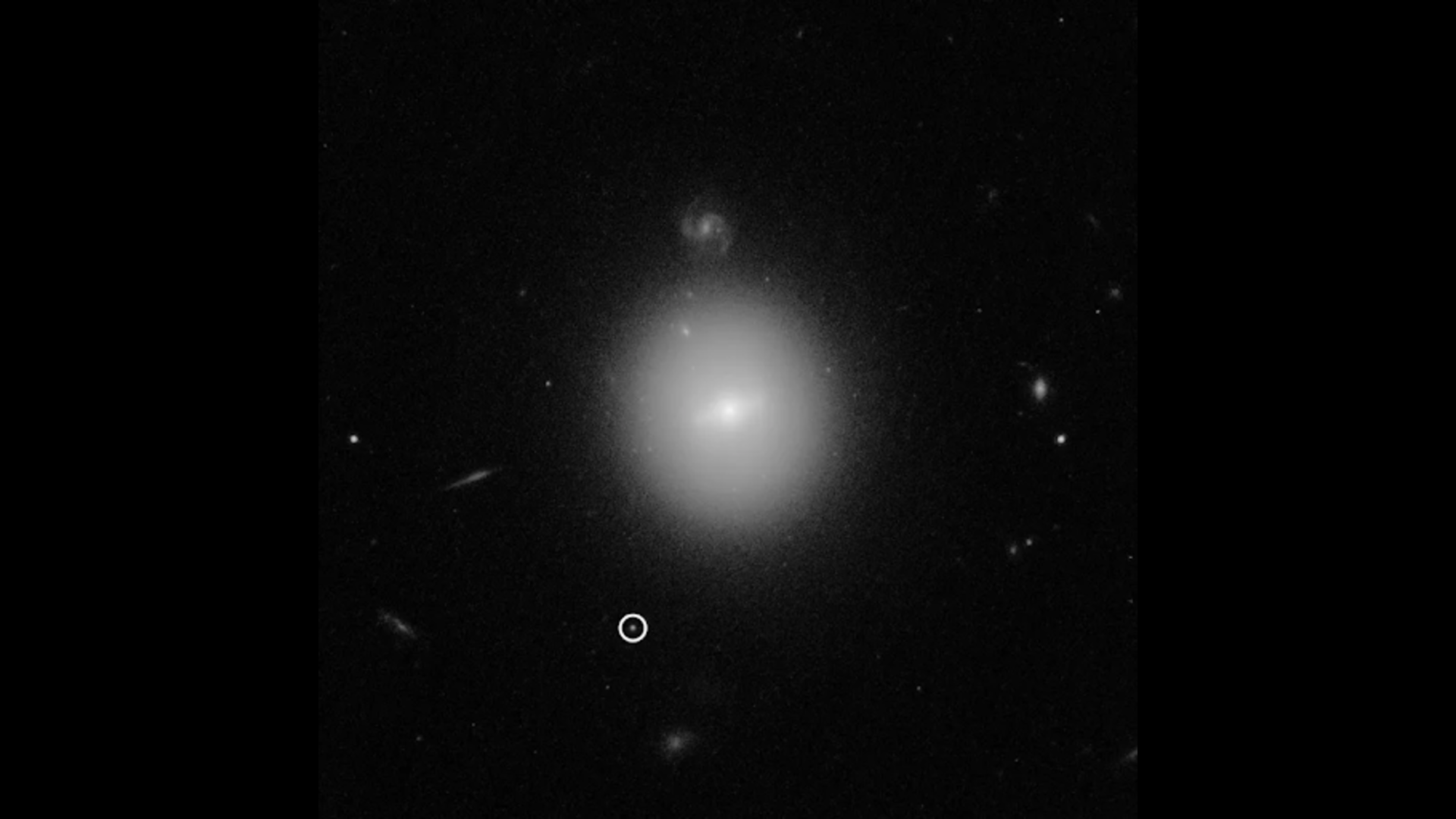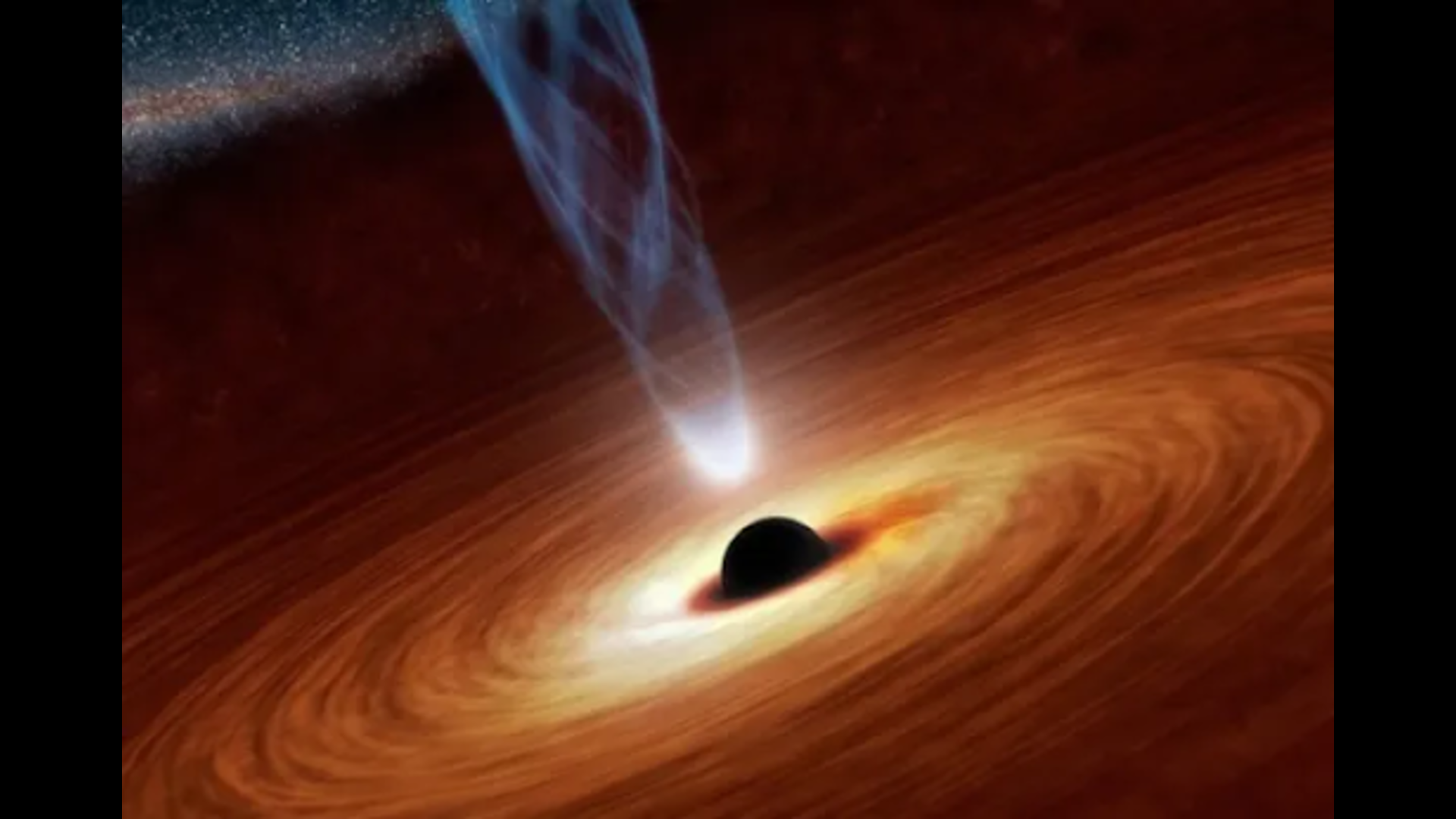Types of Black Holes
There are different types of black holes, and astronomers classify them by mass into three main categories: stellar mass, supermassive, and intermediate mass. The universe may also contain undiscovered examples of a fourth type of black hole, known as primordial black holes, created during the universe’s early stages.
Stellar Black Holes

This is a simulated depiction of black holes bending the starry background and capturing light, forming black hole silhouettes. The image highlights the elusive photon ring, a distinctive feature outlining the black holes.
Image credit: NASA’s Goddard Space Flight Center; background, NASA/JPL-Caltech/UCLA
Stellar black holes are fascinating cosmic entities formed from the remnants of massive stars.
- Formation: Massive stars collapse gravitationally to form stellar black holes. When a massive star exhausts its nuclear fuel, it can no longer support its own weight against gravitational collapse. A supernova explosion occurs when the star’s core collapses quickly, causing the remaining material to collapse even more and form a compact object. If the core’s mass is above a certain threshold (about three times the mass of the Sun), it collapses into a black hole.
- Size: Stellar black holes are smaller than supermassive black holes. They are located in the centres of galaxies and typically have masses ranging from about 3 to 100 times that of the Sun. Their corresponding size can be just a few kilometres in diameter.
- Event Horizon: Stellar black holes, like all other black holes, have an event horizon beyond which nothing can escape—not even light. Anything falling into the black hole will eventually reach this boundary and be lost forever
- Singularity: According to general relativity, the singularity is the point at the centre of a black hole where mass is infinitely dense, and spacetime curvature becomes infinitely steep. The combination of general relativity and quantum mechanics, which continues to be one of the main problems in theoretical physics, is where our current understanding of physics breaks down.
- Accretion Disc: An accretion disc, created by matter pulled in from interstellar space or a companion star, surrounds some stellar black holes. Telescopes can detect black holes with accretion discs because of the intense radiation and heating that result from this material spiralling into the black hole.
- Hawking Radiation: While stellar black holes are predominantly thought to be formed from the collapse of massive stars, they can slowly lose mass over time through a process called Hawking radiation. This occurs due to quantum effects near the event horizon, where pairs of virtual particles are spontaneously created. If one of these particles falls into the black hole while the other escapes, it appears the black hole emits radiation.
Stellar black holes play a crucial role in astrophysics, contributing to our understanding of gravity, spacetime, and the evolution of stars in the universe.
Supermassive Black Holes

A computer-generated visualization illustrates the luminous gas surrounding two supermassive black holes on the brink of merging, offering scientists valuable data for understanding these enigmatic cosmic phenomena.
Image credit: NASA’s Goddard Space Flight Center/Scott Noble
Supermassive black holes, found at the centre of most galaxies, including the Milky Way, are extremely massive cosmic objects. Their masses are between millions and billions of times greater than the Sun’s.
- Formation: Researchers are currently attempting to determine the precise process of forming supermassive black holes. Several theories have been put forth, such as the direct collapse of massive gas clouds, the merger of smaller black holes, and the fast accretion of gas and dust in the early universe. Supermassive black holes may form as a result of any one of these processes.
- Observation: The predominant method of observing supermassive black holes is through their gravitational pull on nearby matter. This includes the stars’ and gas clouds’ high velocities in the vicinity of the galactic centre, which point to the existence of a massive central object. Furthermore, the powerful radiation from the accretion disk—the material falling into the black hole—can be observed at various wavelengths, including radio, ultraviolet, optical, and X-rays.
- Active Galactic Nuclei (AGN): Many galaxies exhibit energetic phenomena known as active galactic nuclei (AGN), which are powered by the accretion of material onto supermassive black holes. AGN can manifest in various forms, including quasars, Seyfert galaxies, and blazars. These phenomena release enormous amounts of energy, making them some of the brightest objects in the universe.
- Function in Galaxy Evolution: Supermassive black holes are essential to developing galaxies. Their gravitational pull can modify the dynamics of gas and stars inside galaxies, controlling the star formation process and the galaxy’s long-term expansion.
Supermassive black holes are fascinating cosmic objects that play a central role in shaping the evolution of galaxies
Intermediate Black Holes

The Hubble Space Telescope’s observation highlights a circled region, potentially housing an intermediate-mass black hole, labelled as 3XMM J215022.4−055108, exhibiting a mass 50,000 times that of our Sun.
Image credit: NASA, ESA and D. Lin (University of New Hampshire)
Intermediate-mass black holes (IMBHs) range from hundreds to tens of thousands of solar masses, bridging the gap between stellar and supermassive black holes.
- Formation: Though their exact origins are unknown, the collapse of massive stars in dense stellar environments, the runaway merging of stellar-mass black holes in globular clusters, or the direct collapse of massive gas clouds are the three main theories regarding the formation of intermediate-mass black holes. It’s possible that intermediate-mass black holes are a stage between supermassive black hole development and development.
- Size and Mass: Intermediate-mass black holes can have masses hundreds to tens of thousands of times greater than the Sun. While they are much bigger than stellar-mass black holes created by the collapse of individual stars, they are smaller than supermassive black holes located at the centres of galaxies.
- Observation: Identifying intermediate-mass black holes presents a challenge due to their rarity and difficulty distinguishing them from other astronomical phenomena. They are typically observed indirectly through their gravitational effects on surrounding matter, such as stars and gas clouds. Some potential candidates for intermediate-mass black holes have been identified in globular clusters, dwarf galaxies, and active star-forming regions.
- Role in Galaxy Evolution: The growth mechanisms of supermassive black holes and their role in galaxy evolution may be clarified by studying intermediate-mass black holes, which is why they are of special interest.
Primordial Black Holes

A primordial black hole formed within the first second of the Big Bang, suggesting an early origin for these mysterious cosmic objects.
Image credit: NASA/ESA and G. Bacon (STScI)
Primordial black holes are theoretical objects believed to have formed soon after the Big Bang in the early universe. They are believed to have originated from fluctuations in the density of matter in the early universe, in contrast to black holes that formed from the collapse of massive stars.
- Formation: Primordial black holes are believed to have formed during the very early stages of the universe, within the first second after the Big Bang. They could have emerged from the gravitational collapse of regions with high-density fluctuations.
- Size and Mass: Primordial black holes could have a wide range of sizes and masses, depending on the conditions present during their formation. They could be as small as a subatomic particle or as large as hundreds of solar masses.
- Detection: Since primordial black holes don’t release light or other electromagnetic radiation, they are difficult to find. Scientists use indirect techniques like microlensing events, gravitational lensing, and hunting for Hawking radiation to infer their existence.
- Hawking Radiation: According to physicist Stephen Hawking’s theory, primordial black holes, like all other black holes, should release Hawking radiation. Black holes exposed to this radiation gradually lose mass and eventually evaporate entirely; however, this process would take a very long time because primordial black holes are small and have low temperatures.
In cosmology and astrophysics, primordial black holes remain intriguing research topics because they may provide fresh perspectives on the early universe and the principles underlying black hole physics.
Each type of black hole plays a crucial role in advancing our understanding of cosmic phenomena and the fundamental laws of physics.
If you enjoyed reading this article, show us your support by purchasing merchandise at our Shop. Alternatively, you could sign up for our newsletter. That’s free
If you would like to read about how black holes form, read this article :


